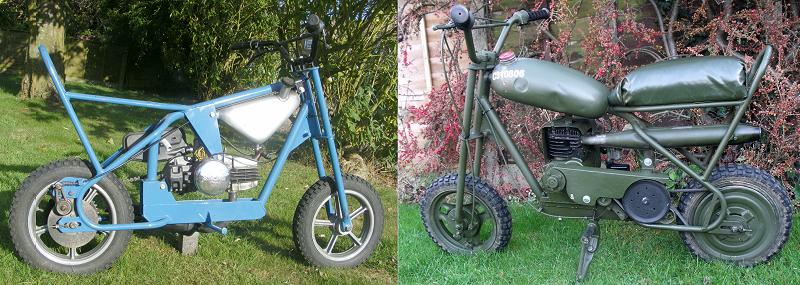‘We shall defend our island, whatever the cost may be, we shall fight on the beaches, we shall fight on the landing grounds, we shall fight in the fields and in the streets, we shall fight in the hills; we shall never surrender’— Winston Churchill
As the relentless battle for urban survival continues, increasingly unlikely vehicles become requisitioned and pressed into service by the beleaguered forces for motor cycling justice—this is Moped Army-2.
Combat has progressed beyond the highway, and is now taking place across the land, up the hills, and in the fields, and these might be some of the stranger things you may never see—let’s off road!
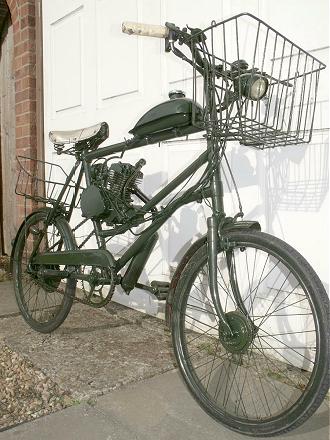
The Moped Army always seems to arrive in some sort of camouflage, and here’s another machine that you may struggle to make out against a background of vegetation. What is that?
We might have to move it somewhere else to distinguish what we have—there. Oh dear, that’s really something horrible!
Maybe going though the origins of this contraption might give some idea how it came about…
The Chinese cyclemotor engine came fitted in a modern and trendy mountain bike frame, but the budget-quality frame fittings really weren’t up to withstanding the assault of a 70cc cyclemotor kit, so things had broken and the project was abandoned as a bad job. It came to Chris (Moped Doctor) Day in a straight swap for a working Mini-Moto, so take out the engine, repair or replace the broken cycle fittings, and sell on the mountain bike so you’re left with a practically new 70cc Chinese cyclemotor kit.
OK, so it wants another more suitable frame now, so what would be the design brief?
Well, the final result wants to be suitable for use as an off-road ‘paddock bike’ at military vehicle rally events, and it’s going to have to carry round a ‘larger’ rider, so a small-wheeled frame might be better to give a lower drive ratio…
After much technical deliberation, and who’d have thought that an absolutely ideal cycle might just happen to be readily available—yes, it’s an Elswick Continentale lady’s shopper with 20-inch wheels!
Possibly not everyone’s first choice, but hey-ho, let’s see how it goes.
Installing the engine wasn’t so straightforward because it wasn’t really intended to fit this type of step-through shopper frame, so when you clamp the back of the engine into place against the saddle stem tube, the front mount doesn’t connect with anything—never mind, just screw a plate against the engine, clamp a U-bolt around the frame and through the plate—fine, that’s sorted.
Being a little concerned about bolting the 43-tooth final drive sprocket to the flimsy 14-gauge rear spokes of a 20-inch lady’s shopper wheel, it seemed likely a more robust fitting might be required—so simply weld the sprocket to the three-speed Sturmey–Archer hub!
Just bolt on the tank further up the top tube, screw on the control fittings, there it’s done—and ready for a first test across the local recreation field.
The low drive ratio from the 20-inch wheels worked out just fine with plenty of pull from the 70cc engine for off-road use—well it would wouldn’t it, because the final drive ratio is 23% down for the intended road gearing on 26-inch wheels, and the whole bike barely weighs 4-stone (which is only a fifth the weight of its rider).
Hammering the bike across the bumpy recreation field—yes, it goes really well—oh, the drive chain’s come off! How did that happen? It was tensioned up OK earlier. Ahhh! The frame’s bent…
Plan-B: Get a couple of mates round to help crowbar the frame back into roughly the right shape again, then weld in a piece of pipe as a crossbar tube—errr, the saddle stem tube is left with a couple of kinks in it now—never mind, just weld the lugs into the tube and that’ll be fine—lovely!
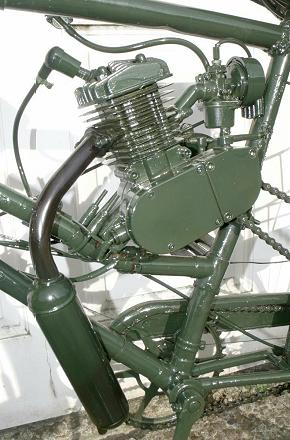
Transfer the fuel tank to the new crossbar pipe, and a generous coat of army green drab to cover the multitude of sins. The Bren gun can go in the front shopper basket, and the ammo cases in the rear carrier—and we’re just about ready to invade Europe!
Aren’t we lucky to be getting the first opportunity to test this latest technical addition to the British military arsenal, before it goes off for a full field trial at the War & Peace military vehicle event?
Now titled by the builder as the ‘Elswick Warrior’ in its full blown ‘militarised’ format, those 20×1-3/8 tyres look just like they were made for serious off-road riding, and those Sturmey–Archer lights driven from the front dyno hub will probably be like blazing searchlights to pin down those Russian T20 tanks in pursuit across the Eastern front—there’ll certainly be no escape for them!
OK, how do we get this thing going?
There’s a tap on the tank on–off (in the middle)–reserve, a crude choke lever on the air filter housing that is obviously no more than a simple strangler, up for on–down for off. A grip-lock clutch lever with vertical spring-loaded pin unlatches automatically when you pull the lever, so that engages the single-speed drive. Can it really be that simple? What could possibly go wrong?
There’s no stand, so just pedal up the road, drop the clutch, and the motor readily fires on a bit of throttle. Even with the choke on, the engine is very responsive—and twitchy. Holding the bike on throttle with your right hand, it’s not so easy to reach across to the choke (also on the right-hand side) with your left hand, but pulling in the left-hand clutch lever doesn’t help much since it’s quite difficult to push and hold down the latch pin at the same time with the same hand. That’s a very awkward grip-lock latch, and certainly no pleasant introduction to control operation.
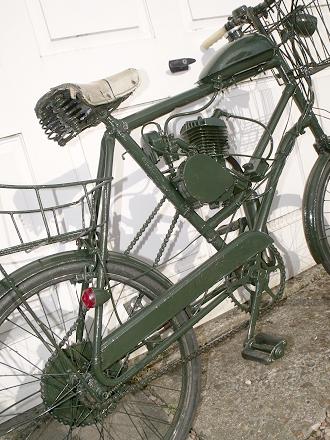
Completing the wobbling choke-off manoeuvre, we get underway, and there’s plenty of torque from the 70cc motor giving brisk acceleration, into nervous and bouncy handling—no surprise there because the bike frame has no suspension.
Yes, a few small bumps and it’s all over the road, take one hand off the bars and you’re dicing with death!
This is a bike that’s going to be more deadly to the rider than any potential enemy!
Getting over the initial shock, we muster some reserve for further assessment. Cruising speeds are just about tolerable up to 18mph, beyond which, all hell breaks loose as the vibration nightmare begins—everything lets go to shake the bike and the rider to pieces. What’s going to go first? Are your eyeballs going to drop out, the fillings fall from your teeth, your brain disengage from your spinal chord, or will the bike simply disintegrate beneath you?
The two-point mounting on this 70cc engine is clearly very lacking, and the low drive ratio just amplifies the vibration problem like you wouldn’t believe. The low gearing allows the bike to actually accelerate up hills, and it could probably even still pull top speed up a gradient, but we’re not sure that the top speed is even survivable. We managed a brief burst up to 33mph (paced) on a downhill run, but the frightening revs and shattering vibrations overcame our nerve to try for any more. It would probably either blow up, or shake to pieces.
Returning from our very brief run, we found the rear brake calliper pivot bolt had shaken its locknut off already.
The best thing about riding this bike was stopping, though this procedure wasn’t helped much by the cycle rim calliper brakes at both front and rear. When you finally grind to a standstill, push the electrical cut-out button underneath the throttle to kill the engine—ahhh! That doesn’t work, so just turn off the petrol tap, and wait for it to run out of fuel…
Next time you want to ride the bike, select the most appropriate gear on the trigger-changer, and just cycle with the pedals.
The only fitted audible means of warning is a bicycle bell, which may not be strictly be legal for a modern motorised vehicle, since the MoT standard now requires continuous note from an electric horn. An electronic CDI/HT ignition box drives the spark, but do these engines even have any generator output? Maybe it’d pass with a squeezy bulb horn?
Since the engine is based on a bicycle, then very little would probably be relevant to general MoT, and the test doesn’t seem to actually involve riding the bike these days, so maybe even a total death-trap like this could technically pass? Riding is one thing, but there may be further ‘complications’ in registering these modern Chinese cyclemotor bicycles without suitable conformity paperwork, and these motors generally fall outside the usual club dating services ‘historic’ remit.
The complications caused by these things really don’t bear thinking about…
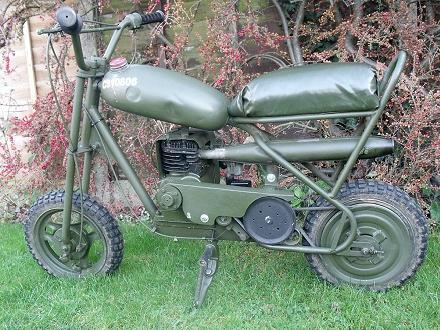
Our second and equally unlikely Moped Army bike is now described as a SIM/Suffolk ‘Iron Horse’, which was created for use as a children’s paddock bike at military vehicle events.
This is another improvisation from junk-pile debris by Chris (Moped Doctor) Day, the chassis coming from an ex-Mannings Amusement Park Mk4 SIM 50 which had been stripped for parts, then abandoned for many years as no more than a bare frame with rigid front forks.
The engine mounting arrangement was modified to take an old Suffolk Iron Foundries 75cc cast-iron lawnmower motor, with transmission enabled by a 60mm engine pulley running Z-belt to a 150mm intermediate reduction pulley, and using belt clutching by a jockey wheel. The intermediate pulley reduces 3:1 by a 50mm back pulley, then driving another 250mm pulley on the rear wheel.
The pressed steel wheels are scavenged from some unknown early Chinese pit bike, which came with fitted 2.50–10 knobbly tyres, and healthy sized brake hubs, so the stopping is very likely to exceed the expected performance.
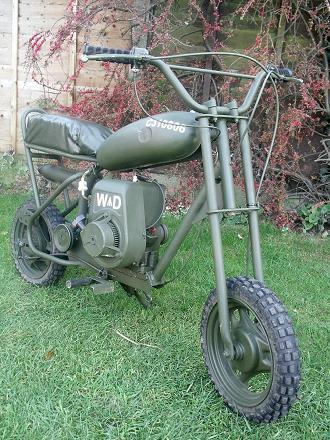
There are more odd parts: a fuel tank from a Raleigh RM4, and a Tomos exhaust squeezed between the frame rails so it exits neatly and directly out the back. The prop stand was adapted from an MZ TS150 rear wheel stand, so it’s rather heavily over-engineered for this application. It really is just bits of all sorts of stuff from the scrap heap.
The classic Suffolk Iron Foundries 75cc side valve engine from a Suffolk Punch lawnmower is exactly what its maker’s name suggests: cast from iron, so the bike may be small, but is no lightweight! To get the engine going there’s a recoil starter, fan-cooling to stop it getting too hot, and with the air-vane governor linkage removed from the Zenith carburettor, so the engine can theoretically rev as much as it is able to survive…
Fuel turns on at bottom left of the tank. We’re told the tickler button on the carb is non-functional, so just use the choke lever to strangle the carb intake.
Pulling the recoil handle won’t work with the clutch lever released to drive, but pulling in the clutch lever and latching it on the lock-off pin doesn’t really help much because the belt doesn’t manage to release from the engine pulley, and still isn’t improved much more by pulling the clutch lever hard up to the grip. The belt clutching still drags too much for a one-man start, so we call in the pace rider to assist, by holding the rear wheel off the ground so we can pull the recoil, control the throttle, and work the choke as required—all at the same time.
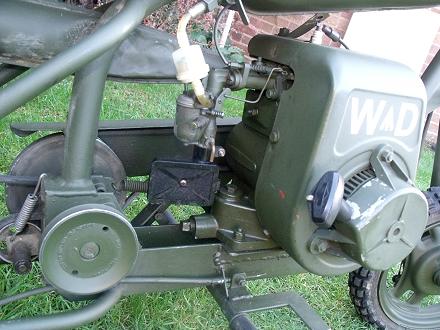
After a couple of spins the old Suffolk engine chugs into life, then there’s a bit of urgent throttle twisting and choke lever twiddling to get it to run clear before we drop the back wheel down and hold the bike against the dragging clutch by using the front brake.
Best to get underway quickly before we burn out the clutching drive belt…
The bike cruises fairly sedately up to 10mph on the flat, and creeps up to 12mph if you hold it on full throttle, but you can tell the engine isn’t so happy in this territory, and delivers a lot of rumbling vibration through the footrests. If you’re feeling particularly merciless, then up to 17mph was momentarily paced downhill in a crouch, but it seems as if the grumbling engine probably wouldn’t last long at these revs.
Forward of the right footrest, there’s a small lever working a cable to the rear brake, but the foot pedal isn’t easily or naturally found since you have to tuck your toe under the engine recoil housing to locate it. While the brake works perfectly well for the very limited performance, you tend to favour the front brake for ease of operation, which is fine on its own at the very low speeds the Iron Horse generally dawdles along at.
The bike proves best when ambling peacefully along at low revs, just as the motor would in a lawnmower, chugging along steadily at jogging pace, and could keep that up all day. Low speed torque of the side-valve engine finds the Iron Horse equally effective off tarmac, on grass, or even through mud—it just keeps plodding along, and can beat walking around the extensive areas of some of these larger military vehicle rallies.
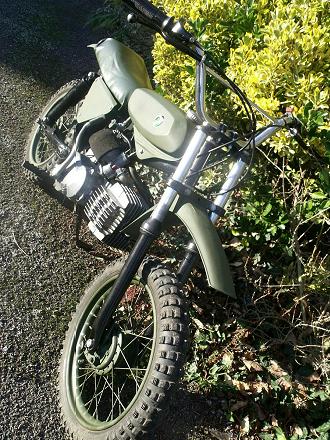
Our third bike may look like a proper scrambler motor cycle in army green camouflage, but its appearance belies the physically small scale of this Puch Magnum X. It might seem a sign of the desperate times when another children’s off-road motor cycle is being pressed into service with the Moped Army, but this looks like a proper Motocrosser, just in miniature.
The Puch engine is based on an E50 Maxi block, with the usual automatic clutch and single speed drive, but a kick-starter mechanism instead of the pedal drive arrangement for typical road going mopeds of the period. Comparing the Magnum X to an E50 Maxi, anyone can be forgiven for thinking they appear like completely different motors, but you have to look a little closer to see the tricks. The Magnum frame covers quite a large portion of the rear engine casing so you only really notice the kick-start casing on the right, and flywheel cover on the left.
Peek underneath the crankcase and sure enough, there’s the Maxi stand bracket on the bottom of the casting, then you can also see the engine is more suitably mounted for off-road use to present the cylinder at an upward angle, instead of horizontal on the street-going Maxi.
The top end assembly is different, but also not new, since Magnum mounts the big-fin, air-cooled type head and barrel from the VZ Sport.
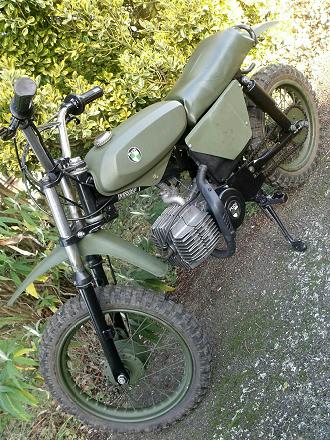
The kick-starter case was initially introduced for the Magnum E50 variant, but subsequently became deployed on Maxi models as various countries redefined their moped definitions to not requiring pedals in the later 1970s, so much the only part remaining unique to the Magnum is the curly inlet manifold to the 17mm Bing carburettor.
Comparative UK market Maxi motors were specified 2.2bhp with the centre plug cylinder head and 14mm carburettor, but some feeling that the automatic Magnum X may require more power for off-road application resulted in its upgraded motor being rated at a very creditable 3.5bhp, and making this the most powerful automatic motor that Puch ever made.
The Magnum stator set is not equipped with any lighting coil, since the off-road application requires no lights. The only electrical circuit as such, is a grounding wire for the ignition system, to a kill switch on the handlebars.
The cycle chassis looks a proper miniature scrambler (’70s style), telescopic forks, swing arm rear suspension and a compact 40-inch wheelbase. The wheels are solidly built on steel rims with 36-spoke lacing onto cast alloy conical hubs and cooling rings set around the brake band, then a 2.50–14 knobbly tyre on the front, and smaller 2.75/3.00–12 knobbly on the rear—these really do look the part!
The petrol tank is steel, while plastic moulded trims including plates for fitting race numbers would have originally covered the main body, but these are long gone from our militarised example, and replaced by fabricated metal panels. The side panels cover the air intake, filter and HT coil on the right, and pan type silencer to the left, which exits through a tailpipe from under the seat. Take a closer look at that flat silencer box, and it might seem familiar—yes, that’s an MS50 box laid sideways—clever old Puch!
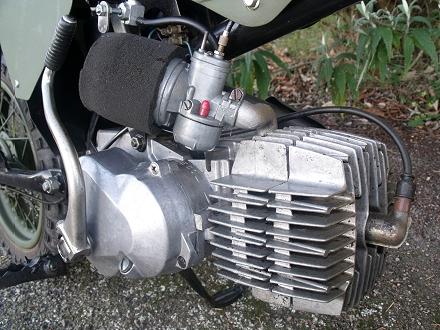
The seat only sits at two feet high, and because of the soft and undamped rear springing being rated for a 6½-stone child, it does compress down somewhat further when an adult of twice that weight sits on it.
The telescopic front forks are sprung and greased, but undamped, though rated a little higher than the rear shocks, so while the back of the bike settles down under load, the front still sits at a similar height, resulting in somewhat of a ‘down at the back’ feel about the riding position.
Fuel turns on under the right-hand back of the tank, and trickles down to the carburettor. Don’t bother with the flood button on a Puch unless it’s too desperately cold to ride anyway, just pressing down the choke to strangle is quite enough. A couple of kicks and the engine rattles into life—yeah, that’s a bad ring rattle, so this little bike has obviously fought in a lot of battles. Children’s motor cycles have a really hard life, so they have to be tough to survive.
We know this tired motor is not going to be as sharp as a good one, so response will be down, but it’s still in service, and because of the low gearing, will still probably manage to rev out.
There’s an initial flat spot as the automatic clutch engages, until the motor pulls through it and into the power band, when the porting kicks in around 10–15mph and the mid range response proves pretty good. The low gearing means the motor is starting to run towards its top end revs around 25mph, and best speed on flat in a crouch clocked of by our pacer at 32mph, at which the motor felt to be seriously over-revving. Maybe not a good idea to hold it flat out at these howling revs for long, though Puch obviously made this a tough little unit because it must have stood this sort of treatment for years!
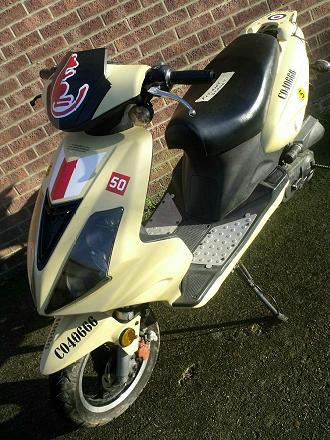
Our fourth and final Moped Army bike seems another highly unlikely offering, it’s an anonymous 2008 Hanglong scooter, and we were none the wiser about what this bike was when we picked it up either…
It seems that a lot of machines coming out of China today are little more than marketing brand labels, and it can be very difficult to find out who the actual manufacturer is, or anything about them—a process that hardly seems likely to create any collectible classics for the future…
This Chinese built Hanglong was cheaply bought as non-running wreck with a plan to fix it up as fake army-style paddock bike at military vehicle shows and, as a change from the usual green drab, it was repainted in sand colour camouflage and trimmed with Desert Rat graphics.
Some aspects of the cycle frame specification seem to be quite good, like the hydraulically damped telescopic front forks, and 120/70–12 tyres on cast alloy wheels, with a single-sided disc front brake fitted with twin-pot calliper. The rear brake appears to be a healthy sized drum around 120mm, which hangs off twin-shock rear suspension. It’s fairly unusual to find many scooters fitted with a right-hand stay-arm and second spring unit, which does make them a little more ‘together’ at the back, while the more common (and cheaper) single-sided suspension strut machines often tend to result in rather sloshy and vague handling.
There’s a proper full-length dual seat, and passenger footrest positions, with a helmet bin beneath the saddle. The electrical system is 12V, with a dipping twin headlamp, remote controlled alarm/immobiliser, and electric starting. There is a kick-starter fitted to the back of the engine case, but we’re not sure you’d be able to get it going on this if the battery was flat, so we prefer to call this ‘the exercise pedal’.
The stainless steel silencer is an aftermarket ‘sport can’, the original having apparently rusted away.
The scooter does appear an overly large and clumsy machine for such a small engine capacity, and is badly let down by all its flimsy and easy-break plastic panels that have all the strength and rigidity of an eggshell.
While this seems a bike with all the gimmicky ‘bells and whistles’ that saturate modern vehicles, ordinarily we’d probably have no interest whatsoever in such a machine, but we are a little intrigued in what the engine is like, because its motor is a 50cc four-stroke with overhead camshaft and fan-cooling!
The first four-stroke 47cc OHC motor cycle was produceded by the Italian Sterzi Company in 1955 and from the early years there’s traditionally been some mystique that an OHC engine would deliver the best four-stroke performance. However, production 50s like the frail Sterzi Pony, Honda P50 and early OHC PC50s never quite worked out like that…
The Chinese 50cc GY6 engine is based on an earlier Honda design, and versions of the motor are produced by a number of different anonymous manufacturers, so it’s quite difficult to identify who the actual source may be. This doesn’t make it any less interesting to see how a modern 50cc OHC four-stroke measures up…
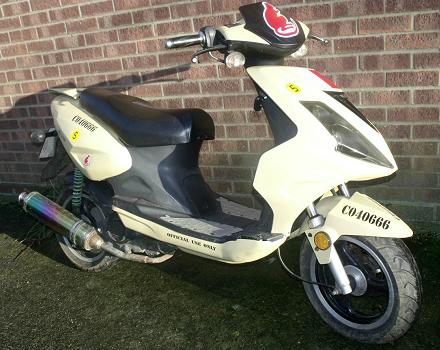
The tank is drained, so slosh in some fuel. Turn on the key, but the battery seems flat, and the starter motor won’t spin, so we hook it up to the charger for a while. The motor hasn’t been run for several months, so we pump the exercise pedal to prime the carburettor from the vacuum tap, and start a bit of oil circulation within the motor. After about half-an-hour on the charger, pull in the front brake lever, push the starter button to spin, and the motor soon fires up in automatic choke phase with higher revs, till it warms in a minute or so, and the revs drop down.
In this limbo period of neither having choke, but not being hot enough tick over yet, you have to hold it to run on throttle, or it peters out and stops.
It proves all too easy to take this bike off its prop stand, because it’s one of those wretched fly-away stands that flicks up on its own as soon as the bike is touched—so guess how all the left-hand panels get broken?
The exhaust note sounds really good, a deep and mellow beat, quiet and subdued, but with a little thump to it that gives you some optimism there might be something there.
We put on the lights because it’s gloomy and pouring with rain today, but the instrument lights still don’t allow us to make out the speedometer dial (marked 0–50), because the dial had faded, and its plastic lens yellowed and bleached by exposure to the blazing Sahara sun. Fortunately we have our pacer at hand once again to take the readings.
The automatic CVT is simple twist-and-go, so we pull away—feels OK—round the corner and open up, but the response seems rather feeble, so we open up more throttle—but that seems to have little more effect? Maybe the engine is too cold at the moment, so we cruise around the lanes a little, then see how she goes down a 1-mile flat straight in an upright stance.
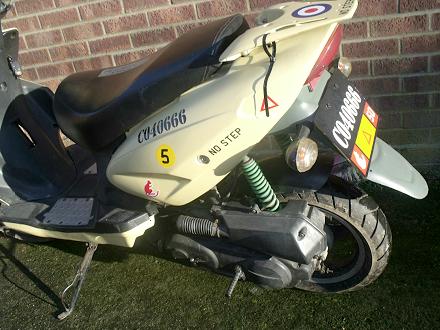
Actually, it doesn’t really seem to go much at all, which is a big disappointment. Beyond 15mph, the engine hardly appears to respond to its throttle. The twistgrip winds round, but is like a very delayed action effect, where there’s just a gradual building up of pace, while the CVT monotonously manages the operation at constant fixed revs. An initial impression is formed very quickly, it’s deadly dull and in danger of boring you to death!
We’re fairly sure that the engine should be well up to temperature by the end of the straight, so turn in the road, but not sure what speed we’ve actually achieved because we couldn’t see the speedo, though we resolved to try harder on the return run. We wait for our pacer to turn in behind us, then give a full throttle run back down the straight, tucking tight in behind the legshield and dipping down as much as possible for a low body profile. The revs do seem to keep creeping up, giving a little more encouragement to press our nose tighter to the instrument console, and slowly the exhaust note edges up toward a musical tone … this is definitely a faster run, but you really have to work it for all you can to get the speed up.
Toward the end of our flat-out, 1-mile straight, the pacer confirmed a peak of 38mph, and felt it might have even got a little higher if we could have held on even further! Sorry, but if there’s any more to go after a mile in a tight tuck, then it’s not worth having!
Our general feeling was that the compression ratio might probably be too low to make the engine reactive, but its performance may not be helped by a soft cam, or small valves—there are several factors which may be responsible for stunted performance in a four-stroke engine, but that’s how it’s supposed to be to comply European market specification.
The front brake felt effective, but the left lever showed too much movement and the rear brake seemed heavy in operation, so probably time for a full cable and lining service.
Handling was generally reasonable enough, though a little firm over bumps at the rear (which is unusual for typical scooters, which invariably seem soft), so this one could skip about for the opposite reason, and any bumps were responded from the bike by an orchestra of creaking and rattling plastic panels from everywhere.
It was interesting to briefly try one of these modern four-stroke scooters, but they’d be a god-forsaken and soulless thing to ride every day.


